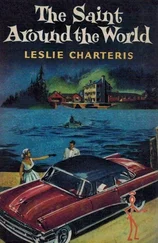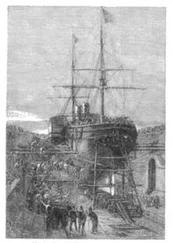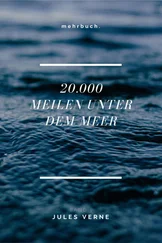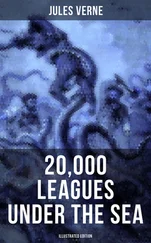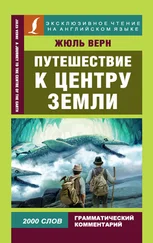The outlines of the continents allow the seas to be divided into five major parts: the frozen Arctic and Antarctic oceans, the Indian Ocean, the Atlantic Ocean, and the Pacific Ocean.
The Pacific Ocean extends north to south between the two polar circles and east to west between America and Asia over an expanse of 145 degrees of longitude. It’s the most tranquil of the seas; its currents are wide and slow-moving, its tides moderate, its rainfall abundant. And this was the ocean that I was first destined to cross under these strangest of auspices.
“If you don’t mind, professor,” Captain Nemo told me, “we’ll determine our exact position and fix the starting point of our voyage. It’s fifteen minutes before noon. I’m going to rise to the surface of the water.”
The captain pressed an electric bell three times. The pumps began to expel water from the ballast tanks; on the pressure gauge, a needle marked the decreasing pressures that indicated the Nautilus’s upward progress; then the needle stopped.
“Here we are,” the captain said.
I made my way to the central companionway, which led to the platform. I climbed its metal steps, passed through the open hatches, and arrived topside on the Nautilus.
The platform emerged only eighty centimeters above the waves. The Nautilus’s bow and stern boasted that spindle-shaped outline that had caused the ship to be compared appropriately to a long cigar. I noted the slight overlap of its sheet-iron plates, which resembled the scales covering the bodies of our big land reptiles. So I had a perfectly natural explanation for why, despite the best spyglasses, this boat had always been mistaken for a marine animal.
Near the middle of the platform, the skiff was half set in the ship’s hull, making a slight bulge. Fore and aft stood two cupolas of moderate height, their sides slanting and partly inset with heavy biconvex glass, one reserved for the helmsman steering the Nautilus, the other for the brilliance of the powerful electric beacon lighting his way.
The sea was magnificent, the skies clear. This long aquatic vehicle could barely feel the broad undulations of the ocean. A mild breeze out of the east rippled the surface of the water. Free of all mist, the horizon was ideal for taking sights.
There was nothing to be seen. Not a reef, not an islet. No more Abraham Lincoln. A deserted immenseness.
Raising his sextant, Captain Nemo took the altitude of the sun, which would give him his latitude. He waited for a few minutes until the orb touched the rim of the horizon. While he was taking his sights, he didn’t move a muscle, and the instrument couldn’t have been steadier in hands made out of marble.
“Noon,” he said. “Professor, whenever you’re ready… .”
I took one last look at the sea, a little yellowish near the landing places of Japan, and I went below again to the main lounge.
There the captain fixed his position and used a chronometer to calculate his longitude, which he double-checked against his previous observations of hour angles. Then he told me:
“Professor Aronnax, we’re in longitude 137 degrees 15’ west—”
“West of which meridian?” I asked quickly, hoping the captain’s reply might give me a clue to his nationality.
“Sir,” he answered me, “I have chronometers variously set to the meridians of Paris, Greenwich, and Washington, D.C. But in your honor, I’ll use the one for Paris.”
This reply told me nothing. I bowed, and the commander went on:
“We’re in longitude 137 degrees 15’ west of the meridian of Paris, and latitude 30 degrees 7’ north, in other words, about 300 miles from the shores of Japan. At noon on this day of November 8, we hereby begin our voyage of exploration under the waters.”
“May God be with us!” I replied.
“And now, professor,” the captain added, “I’ll leave you to your intellectual pursuits. I’ve set our course east-northeast at a depth of fifty meters. Here are some large-scale charts on which you’ll be able to follow that course. The lounge is at your disposal, and with your permission, I’ll take my leave.”
Captain Nemo bowed. I was left to myself, lost in my thoughts. They all centered on the Nautilus’s commander. Would I ever learn the nationality of this eccentric man who had boasted of having none? His sworn hate for humanity, a hate that perhaps was bent on some dreadful revenge—what had provoked it? Was he one of those unappreciated scholars, one of those geniuses “embittered by the world,” as Conseil expressed it, a latter-day Galileo, or maybe one of those men of science, like America’s Commander Maury, whose careers were ruined by political revolutions? I couldn’t say yet. As for me, whom fate had just brought aboard his vessel, whose life he had held in the balance: he had received me coolly but hospitably. Only, he never took the hand I extended to him. He never extended his own.
For an entire hour I was deep in these musings, trying to probe this mystery that fascinated me so. Then my eyes focused on a huge world map displayed on the table, and I put my finger on the very spot where our just-determined longitude and latitude intersected.
Like the continents, the sea has its rivers. These are exclusive currents that can be identified by their temperature and color, the most remarkable being the one called the Gulf Stream. Science has defined the global paths of five chief currents: one in the north Atlantic, a second in the south Atlantic, a third in the north Pacific, a fourth in the south Pacific, and a fifth in the southern Indian Ocean. Also it’s likely that a sixth current used to exist in the northern Indian Ocean, when the Caspian and Aral Seas joined up with certain large Asian lakes to form a single uniform expanse of water.
Now then, at the spot indicated on the world map, one of these seagoing rivers was rolling by, the Kuroshio of the Japanese, the Black Current: heated by perpendicular rays from the tropical sun, it leaves the Bay of Bengal, crosses the Strait of Malacca, goes up the shores of Asia, and curves into the north Pacific as far as the Aleutian Islands, carrying along trunks of camphor trees and other local items, the pure indigo of its warm waters sharply contrasting with the ocean’s waves. It was this current the Nautilus was about to cross. I watched it on the map with my eyes, I saw it lose itself in the immenseness of the Pacific, and I felt myself swept along with it, when Ned Land and Conseil appeared in the lounge doorway.
My two gallant companions stood petrified at the sight of the wonders on display.
“Where are we?” the Canadian exclaimed. “In the Quebec Museum?”
“Begging master’s pardon,” Conseil answered, “but this seems more like the Sommerard artifacts exhibition!”
“My friends,” I replied, signaling them to enter, “you’re in neither Canada nor France, but securely aboard the Nautilus, fifty meters below sea level.”
“If master says so, then so be it,” Conseil answered. “But in all honesty, this lounge is enough to astonish even someone Flemish like myself.”
“Indulge your astonishment, my friend, and have a look, because there’s plenty of work here for a classifier of your talents.”
Conseil needed no encouraging. Bending over the glass cases, the gallant lad was already muttering choice words from the naturalist’s vocabulary: class Gastropoda, family Buccinoidea, genus cowry, species Cypraea madagascariensis, etc.
Meanwhile Ned Land, less dedicated to conchology, questioned me about my interview with Captain Nemo. Had I discovered who he was, where he came from, where he was heading, how deep he was taking us? In short, a thousand questions I had no time to answer.
I told him everything I knew—or, rather, everything I didn’t know— and I asked him what he had seen or heard on his part.
Читать дальше

